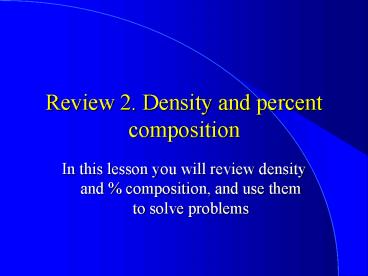Review 2' Density and percent composition - PowerPoint PPT Presentation
1 / 15
Title:
Review 2' Density and percent composition
Description:
Review 2' Density and percent composition – PowerPoint PPT presentation
Number of Views:355
Avg rating:3.0/5.0
Title: Review 2' Density and percent composition
1
Review 2. Density and percent composition
- In this lesson you will review density and
composition, and use them to solve problems
2
Definition of density
- Density is the ratio of sample mass to sample
volume - d m V
- Density depends only on the composition of the
sample, not on the amount of material present
3
Density is a conversion factor
- A conversion factor is a relationship between two
properties or quantities, expressed as a fraction
or ratio - Density is a conversion factor that shows the
relationship between mass and volume.
4
Solve this density problem
- 385 mL of mercury weighs 5.23 kg. What is the
density of mercury, in g/mL? - 5.23 kg x 1000 g 5230 g 1 kg
- d m 5230 g 13.6 g V 385 mL
mL
5
Solve this density problem
- Ethylene glycol has a density of 1.11 g/mL. What
is the mass of 18.6 L of ethylene glycol? - 18.6 L x 1000 mL x 1.11 g 20,646 g
1 L 1 mL - Round off answer to 3 significant digits ? 20.6
x 103 g or 20,600 g
6
Solve this density problem
- Ethyl alcohol has a density of 0.789 g/mL. What
is the volume of 235 g of ethyl alcohol? - 235 g x 1 mL 297.845384 mL 298 mL
0.789 g - Density was inverted to make units cancel
properly, but relationship is still valid
7
Composition of a sample percent by mass
- If a sugar solution is 5 sugar by mass, it
contains 5 g sugar 100 g solution - Notice units are same in numerator denominator,
but labels are different - Composition may also be by volume (volume units
instead of mass units)
8
Solve this composition problem
- 825 g of ore are found to contain 137 g of
aluminum. What is the aluminum in this ore, by
mass? - 137 g Al x 100 16.6 Al 825 g ore
9
Solve this composition problem
- A fertilizer contains 21 nitrogen by mass. What
mass of fertilizer (in kg) should be applied to
supply 775 g nitrogen? - 775 g nitrogen x 100 g fertilizer x 1 kg
21 g nitrogen 1000 g - 3.7 kg fertilizer needed (2 sig digits)
- Units (g) are same labels must cancel!
10
Many problems require both density and
composition
- A solution that is 8.50 acetone 91.50 water,
by mass, has a density of 0.9867 g/mL. What mass
of acetone is present in 750. mL of the
solution? - 750. mL soln x 0.9867 g soln x 8.50 g
acetone 1 mL soln 100 g soln - 62.9 g acetone
- Labels as well as units must cancel
11
Solve this problem
- A sucrosewater solution is 28.0 sucrose by mass
and has a density of 1.118 g/mL. What mass of
sucrose is in 2.75 L of this solution? - 2.75 L soln x 1000 mL x 1.118 g soln x 28.0 g
sucrose 1 L 1 mL soln 100 g soln - 861 g sucrose
12
Solve this problem
- Pool acid is 36 hydrochloric acid by mass and
has a density of 1.179 g/mL. How many liters of
acid solution should you use to add 5.0 x 102 g
acid to the pool? - 500 g acid x 100 g soln x 1mL soln x 1
L 36 g acid 1.179 g soln 1000mL - Add 1.2 L acid solution
13
Reminder
- The most common mistake students make when
setting up these problems is to invert a factor
or use it in the wrong place. - They dont catch their mistake because they
neglect to label the units. The units cancel,
but the labels dont.
14
The bottom line
- You should be able to define density, calculate
its value from data, and use it to convert
between mass and volume. - You should be able to calculate percent
composition by mass from data and use it to solve
problems. - You should be able to combine density and
composition to solve problems
15
Where to get more information
- If you feel insecure on the topic of density,
consult pages 20 and 32-33 in your text - For more about percent composition, see page 537
in your text or ask me for help - If you are goofing on metric prefixes, review
page 19 in your text































